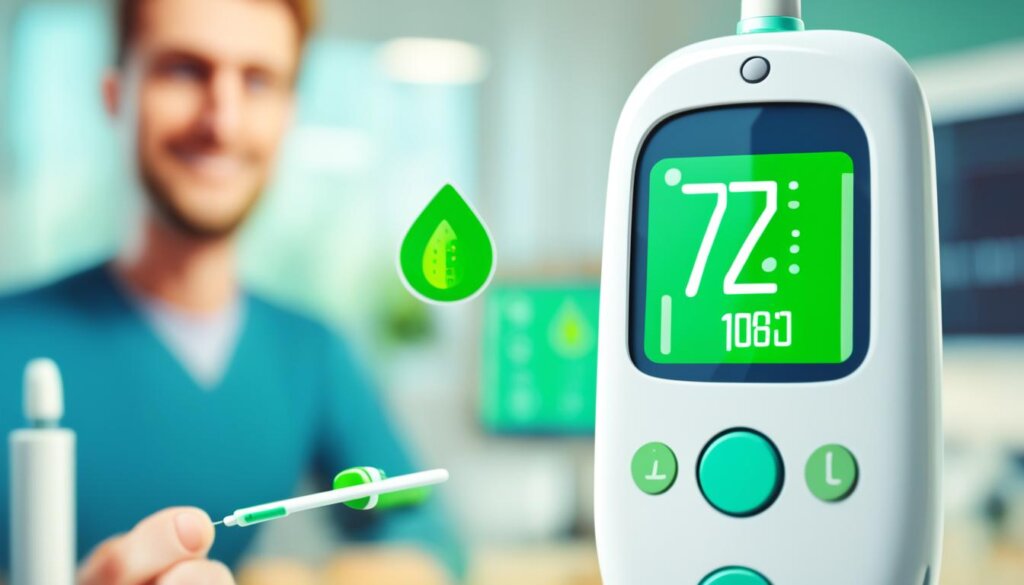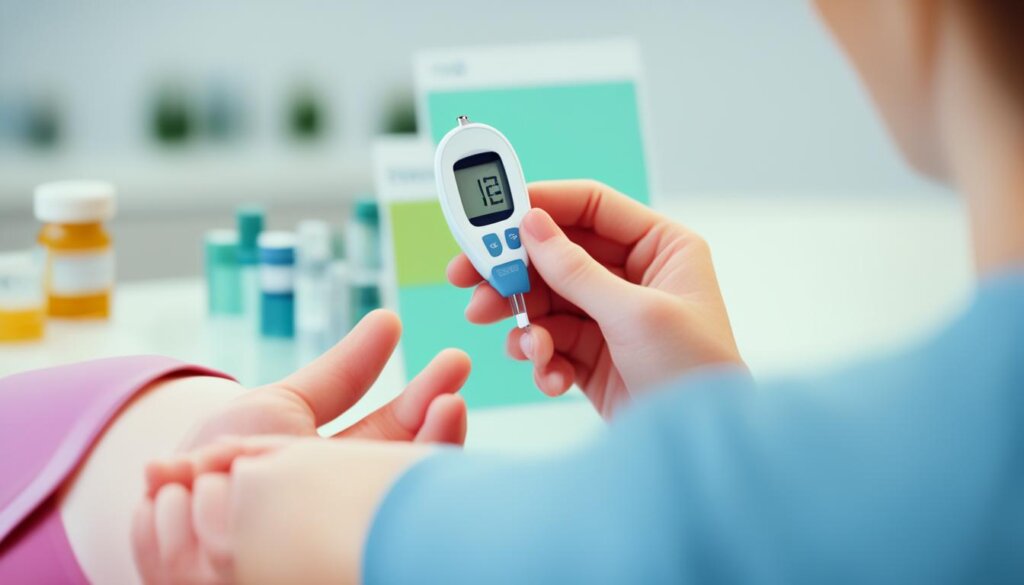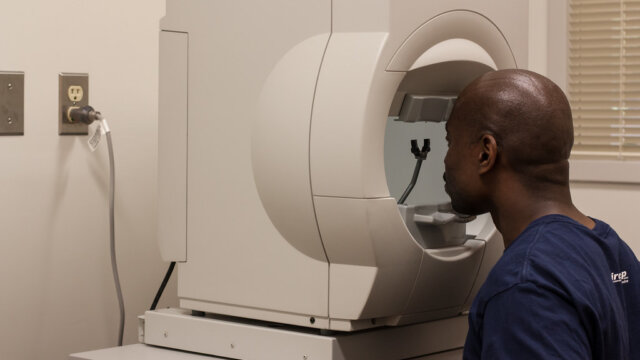FTC disclaimer: This post may contains affiliate links and we will be compensated if you click on a link and make a purchase.
A simple blood test called the A1C test can tell you a lot about your blood sugar control over time. This test looks at the glucose attached to your red blood cells for the past 2-3 months. Knowing your A1C level is key for spotting prediabetes and diabetes, and for keeping track of your health if you have diabetes.
The A1C test is a big help in fighting diabetes, a disease that affects many Americans. It tracks your average blood sugar levels. This way, you and your doctor can spot problems early and manage your diabetes or prevent it.
Key Takeaways
- The A1C test measures your average blood glucose levels over the past 2-3 months.
- A normal A1C level is below 5.7%, while prediabetes is indicated by levels between 5.7-6.4%.
- Diabetes is diagnosed when the A1C level is 6.5% or higher.
- The A1C test can help monitor your diabetes treatment plan and reduce the risk of complications.
- Certain factors, such as hemoglobin variants and medical conditions, can affect the accuracy of A1C test results.
Understanding the A1C Test
The A1C test checks your average blood sugar levels over 2-3 months. It looks at how much glucose is attached to your hemoglobin. The more glucose in your blood, the more it sticks to your hemoglobin, raising your A1C level.
Measuring Average Blood Glucose Levels
Since the 1990s, the A1C test has been key in managing diabetes. It shows your glucose control better than single blood tests, which change a lot during the day. The American Diabetes Association says to test your A1C twice a year if you have diabetes to keep your levels in check.
Significance of Glycated Hemoglobin
Glycated hemoglobin, or hemoglobin with glucose on it, is what the A1C test looks at. This shows the average glucose in your blood over 2-3 months. It helps spot patterns in your glucose control and guide treatment choices.
The goal A1C level is 7% or lower for most adults not pregnant. But, your age, health issues, and support can change your A1C goal. You can also turn A1C into estimated average glucose (eAG) with a calculator for easier understanding.
Some health issues and medicines can affect how accurate the A1C test is. Kidney failure, liver disease, and some drugs can make the test less reliable. Also, the test doesn’t show daily blood sugar changes, just an average over time.
“The A1C test provides a more comprehensive picture of your overall glucose control compared to single blood glucose readings.”
Why Get an A1C Test?
The A1C test is key for finding prediabetes and type 2 diabetes. It also checks how well your diabetes treatment is working. If your A1C is between 5.7% and 6.4%, you’re at risk of getting diabetes. If it’s 6.5% or higher, you have diabetes.
Diagnosing Prediabetes and Diabetes
The A1C test shows your average blood sugar over 2-3 months. Your doctor can tell if you have prediabetes or diabetes with these results. It’s key for people at risk, like those who are overweight or have diabetes in their family.
Monitoring Diabetes Treatment Plan
After diabetes diagnosis, the A1C test helps check your treatment’s success. Your doctor will adjust your treatment if needed, like your meds or diet. The goal is to keep your A1C at 7% or lower to prevent complications. People with diabetes should get tested at least twice a year.
Some conditions can affect A1C results, like anemia or liver disease. Talk to your doctor if you have these issues.

“Regular A1C testing is essential for managing diabetes and preventing long-term complications. It’s a simple, effective way to monitor your progress and make informed decisions about your treatment plan.”
A1C Test for Diabetes Diagnosis
The A1C test is key in spotting diabetes and prediabetes. It checks your blood sugar levels over 2-3 months. This gives a clear view of your blood glucose monitoring and hemoglobin A1c levels.
A1C Levels and Interpretation
Here’s how the A1C test is read for diagnosis:
- Below 5.7% is normal
- 5.7% to 6.4% means you might have prediabetes
- 6.5% or higher on two tests shows diabetes
Don’t use the A1C test for type 1 diabetes, gestational diabetes, or cystic fibrosis-related diabetes. It might not give right results in these cases. Your doctor will likely check again with the A1C test or another test like the FPG or OGTT.

Knowing your glycated hemoglobin levels helps you manage your diabetes. It lets you work with your doctor on a good treatment plan.
Using the A1C Test During Pregnancy
For pregnant women, keeping an eye on blood sugar is key. Diabetes can be risky for both mom and baby. The A1C test helps doctors see your average blood sugar levels over the past 3 months.
Early in pregnancy, the A1C test can spot diabetes before it’s diagnosed. But, tests like the glucose challenge test or oral glucose tolerance test (OGTT) are mainly used to check for gestational diabetes. If a woman had gestational diabetes, she should get tested for diabetes again no more than 12 weeks after giving birth.
Keeping blood sugar in check during pregnancy is very important. If your A1C was 10% or higher before getting pregnant, your baby might have a higher risk of birth defects. But, if your A1C was 6.5% or less, the risk is the same as for women without diabetes.
The American Diabetes Association says to test for diabetes at the first prenatal visit. The American College of Obstetricians and Gynecologists also suggests that women with diabetes are at high risk for preeclampsia. They recommend taking a baby aspirin daily after 12 weeks to lower this risk.
Women with diabetes may need more insulin by the end of the third trimester because of insulin resistance. Women with diabetes might also have their baby induced earlier, around 37 to 38 weeks.
Keeping blood sugar levels in check is key for a healthy pregnancy and baby. Using the A1C test and other glucose tests, along with working closely with healthcare providers, can help ensure the best outcomes for women with diabetes during pregnancy.

Other Blood Glucose Tests for Diagnosis
Healthcare providers use tests like the A1C test to find type 2 diabetes and prediabetes. They also use the fasting plasma glucose (FPG) test and the oral glucose tolerance test (OGTT).
Fasting Plasma Glucose (FPG) Test
The FPG test checks your blood sugar after an 8-hour fast. Normal levels are below 99 mg/dL. Levels between 100-125 mg/dL show prediabetes, and above 126 mg/dL means diabetes.
Oral Glucose Tolerance Test (OGTT)
The OGTT tests your blood sugar after drinking a sugary drink. Normal levels are below 140 mg/dL. Levels between 140-199 mg/dL mean prediabetes, and above 200 mg/dL means diabetes.
These tests, along with the A1C test, give a full picture of your glucose levels. They help confirm if you have diabetes or prediabetes.
Test | Normal | Prediabetes | Diabetes |
|---|---|---|---|
A1C | Below 5.7% | 5.7-6.4% | 6.5% or above |
Fasting Plasma Glucose (FPG) | 99 mg/dL or below | 100-125 mg/dL | 126 mg/dL or above |
Oral Glucose Tolerance Test (OGTT) | 140 mg/dL or below | 140-199 mg/dL | 200 mg/dL or above |
These tests, along with the A1C test, give a full picture of your glucose levels. They help confirm if you have diabetes or prediabetes.
Factors Affecting A1C Test Results
The A1C test is key for diagnosing and tracking diabetes. But, many things can change how accurate the results are. For example, recent blood loss, sickle cell disease, or anemia can change A1C levels.
Some hemoglobin variants, common in people from Africa, the Mediterranean, or Southeast Asia, can also mess with the test, making results too high or too low. Plus, small changes in temperature or how the lab handles the sample can cause tiny differences in results.
Hemoglobin Variants and Red Blood Cell Lifespan
People with certain hemoglobin variants, like hemoglobin C or S, might get wrong A1C results. Also, things that change red blood cell lifespan, like blood loss or transfusions, can affect A1C levels. This is because the test looks at how much glucose is attached to hemoglobin in the blood.
Sample Handling and Laboratory Variations
How blood samples are handled and tested in the lab can also affect A1C results. Small changes in temperature, equipment, or how the sample is processed can cause tiny differences in readings. This shows why it’s important to work with a trusted lab and doctor for the most accurate A1C results.
A1C Value | eAG Value | Diagnosis |
|---|---|---|
5.6% or less | 117 mg/dl or less | Normal |
5.7–6.4% | 117–137 mg/dl | Prediabetes |
6.5% or more | 137 mg/dl or more | Diabetes |

Talking to your healthcare provider about any factors that might change your A1C results is key. Knowing the limits and variations of the A1C test helps people with diabetes work with their medical team for accurate monitoring and good management of their condition.
A1C Test Precision and Reliability
The A1C test has gotten more precise over time. This is thanks to better quality control standards. When you test again, your A1C result usually changes by about 0.4 points. For example, a test might show 6.8%, but it could be between 6.4% and 7.2% on another test.
This precision helps you manage your diabetes better. Health experts know about these small changes. They might test again to make sure the results are right and to help with your treatment.
But, the A1C test isn’t perfect. Some things can affect how accurate it is. A study looked at 8,984 patients and found the test was good at spotting diabetes with a level of 6.3%. Also, the test works differently for different groups of people. For example, it was more accurate for Mexican Americans and blacks than for non-Hispanic whites.
A1C Level | Interpretation |
|---|---|
5.6% or below | Normal |
5.7% to 6.4% | Prediabetes |
6.5% or above | Diabetes |
The A1C test is getting better, but it’s not perfect. Some people might get wrong results because of kidney failure, liver disease, or anemia. Also, some hemoglobin types can mess with the test for people from certain places. So, doctors have to be careful when reading the results.
The A1C test is now more precise and reliable. It’s a key tool for checking blood sugar and managing diabetes. But, doctors need to be careful with the results. They should think about things that might change the test’s accuracy.
A1C Test for Diabetes: What You Need to Know
The hemoglobin A1C (A1C) test is key for diagnosing and managing diabetes. This test shows your average blood sugar levels over 2-3 months. It helps your healthcare team check how well you’re controlling your glucose.
An A1C below 5.7% is normal. Levels between 5.7% and 6.4% mean you might have prediabetes. A reading of 6.5% or higher on two tests confirms diabetes. Testing regularly is vital to see if your diabetes treatment is working. It helps adjust your plan to keep your blood sugar right.
Adults over 45 should get this test for a baseline. Those under 45 with risk factors like being overweight or having prediabetes should also be tested. For people with diabetes, keeping an A1C below 7% is the goal. This means an average glucose level of about 154 mg/dL (8.5 mmol/L).
Remember, ethnicity can affect how accurate A1C tests are. This is true for people of African, Mediterranean, or Southeast Asian descent. Also, there’s a +/- 0.5% error in A1C tests. So, your doctor might test you again to confirm the results.
High A1C levels raise the risk of heart disease, kidney disease, nerve damage, eye problems, foot issues, and slow healing. If you have diabetes or prediabetes, you might need to change your lifestyle or take medicine to lower your A1C.
Interpreting A1C Results for Treatment
The A1C test is key for diagnosing and managing diabetes. For most adults, aiming for an A1C level under 7% is important to lower the risk of complications. Your A1C goal might change based on your age and health conditions. Your doctor will help set a goal that fits your needs.
Setting A1C Goals
Managing your blood sugar well is the main goal of diabetes care. The A1C test shows your average blood sugar over time. A level of 6.8% means your blood sugar is well-controlled. But, a level of 9.6% means it’s been high lately. Your doctor will work with you to find the best A1C target, considering your age, diabetes duration, and other health issues.
Relationship with Estimated Average Glucose (eAG)
Your doctor might also talk about an “estimated average glucose” (eAG) value. This is closer to what you see on your home glucose meter. To find eAG (mg/dL) from A1C (%), use this formula: eAG (mg/dL) = 28.7 x NGSP-A1C (%) – 46.7. Knowing how A1C and eAG relate helps you understand your test results better and manage your diabetes.
Working with your healthcare team to set good A1C goals and understanding A1C and eAG helps you manage your blood sugar well.
A1C Level | Average Blood Glucose Level | Condition |
|---|---|---|
Below 5.7% | Less than 126 mg/dL | Normal |
5.7% – 6.4% | 126 – 151 mg/dL | Prediabetes |
6.5% or higher | 152 mg/dL or higher | Diabetes |
“The A1C test not only helps diagnose diabetes, but it also plays a crucial role in managing the condition.”
Conclusion
The A1C test has changed how we handle diabetes. It shows your average blood sugar levels over 2-3 months. This is key for spotting prediabetes or diabetes and checking if your treatment works.
Testing your A1C regularly helps you and your doctor keep your blood sugar levels right. This lowers the chance of diabetes-related complications. Pharmacists are very important in diabetes monitoring. They give advice on medicines, lifestyle changes, and managing the disease.
Knowing how the A1C test works helps you manage your diabetes better. Tools like the A1CNOW® SELF CHECK let you check your blood sugar control at home. This way, you can work better with your healthcare team to reach your diabetes goals.
FAQ
What is the A1C test?
The A1C test checks your blood sugar levels over the past 2-3 months. It looks at how much glucose is attached to your red blood cells. This helps diagnose type 1 and type 2 diabetes.
How does the A1C test work?
The test looks at your blood’s hemoglobin with glucose attached. This shows your average blood sugar levels over 2-3 months. It gives a full view of your glucose control.
Why is the A1C test important?
This test finds prediabetes and type 2 diabetes. It checks how well you manage your blood sugar if you have diabetes. It helps your healthcare team see if your diabetes treatment is working.
How are A1C levels interpreted?
Levels below 5.7% are normal. Levels from 5.7% to 6.4% mean prediabetes. Levels of 6.5% or higher on two tests show diabetes.
How is the A1C test used during pregnancy?
Early in pregnancy, it checks for diabetes. But, the glucose challenge test or oral glucose tolerance test (OGTT) are mainly used to find gestational diabetes.
What other blood glucose tests are used to diagnose diabetes?
Besides the A1C test, the fasting plasma glucose (FPG) test and the oral glucose tolerance test (OGTT) are used. They help diagnose type 2 diabetes and prediabetes.
What factors can affect the accuracy of the A1C test?
Things like red blood cell lifespan, certain hemoglobin types, and small changes in temperature can affect the test’s accuracy. So can equipment or sample handling issues in the lab.
How precise is the A1C test?
The test has gotten more precise, with results usually differing by about 0.4 percentage points. This precision helps in managing diabetes and adjusting treatments.
How are A1C results used to manage diabetes?
For most adults with diabetes, aiming for an A1C level under 7% is key to lowering the risk of complications. Your healthcare team will help set a target A1C level that fits your needs.
How is the relationship between A1C and estimated average glucose (eAG) important?
Knowing how A1C and eAG relate helps you understand your test results better. Your healthcare team can guide you on using this info to control your glucose levels.








